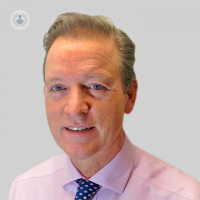Therapeutic mammoplasty: am I suitable for the procedure?
Written by:Therapeutic mammoplasty is a relatively new surgical procedure. The operation removes the breast cancer (therapeutic) and then reshapes the breast by removing its skin and tissue (mammoplasty) to preserve a normal breast shape.
Here, one of our highly-experienced oncoplastic breast surgeons Mr Brendan Smith explains just who is suited to having therapeutic mammoplasty and outlines the advantages versus the disadvantages of the procedure.

Where did the term ‘therapeutic mammoplasty’ originate?
Broken down, the word mammoplasty means breast ('mammo') remodelling or reshaping ('plasty').
Previously, mammoplasty was exclusively used by plastic surgeons who were undertaking cosmetic breast surgery, such as reduction mammoplasty (breast reduction) or augmentation mammoplasty (breast enlargement).
With the integration of breast plastic surgery techniques being incorporated into the training of the modern breast cancer (oncoplastic) surgeons, the skills of both cancer (oncology) surgeon and cosmetic plastic breast surgery are combined.
Therapeutic mammoplasty evolved from this combination of skills and is the term given to operations to remove breast cancers (therapeutic) and internally fill the resulting defect with your own breast tissue, then reshape the breast (mammoplasty).
This is done by removing skin and possibly other breast tissue so that we try and preserve a normal breast shape that will usually be smaller and more uplifted. This technique allows us to remove more breast tissue and usually leaves an acceptable aesthetic outcome compared to a standard lumpectomy.
Who is suitable for therapeutic mammoplasty?
Therapeutic mammoplasty has become the standard of care for breast conservation in the majority of patients. Approximately 70% of our patients are suitable for this procedure. If your surgeon has not offered you this then please ask why.
This operation is usually not suitable to be done after radiotherapy if the initial cosmetic results are poor. The operation is most suitable for women with moderate to larger breasts who have a degree of droop. Modifications of the techniques, however, can sometimes be used for women with smaller breasts.
If there is a significant asymmetry between your breasts afterwards, you may wish for the breast on the other side to be reduced to provide a better match in size and shape. This is known as symmetrisation surgery that can be performed at a later date.
What are the advantages?
The advantages of therapeutic mammoplasty include that:
- It aims to produce a normal breast shape and is particularly useful for lower breast tumours, which are more likely to develop a deformity if a simple lumpectomy is performed. For women with larger breasts who desire smaller breasts, it is an added benefit.
- In cases where women have large breasts, reduction in size can make radiotherapy easier.
- A breast that is internally reconstructed using breast tissue displacement is more natural and stable when compared to total breast reconstruction with an implant or with tissue from elsewhere in the body.
- Recovery from the operation is also much quicker for most women.
What are the disadvantages?
The disadvantages are:
- The surgery is more extensive than a simple lumpectomy with more scarring.
- There are more risks associated with the surgery, including altered nipple sensation or numbness, the potential for nipple (1%) and fat necrosis, and problems with wound healing. These will be discussed in more detail later.
- A specific cosmetic outcome cannot be guaranteed and there is still a risk you may have a degree of distortion or indentation.
What are the other surgical options for breast cancer treatment?
The other surgical options are:
- Simple lumpectomy (wide local excision) without reshaping the breast.
- Mastectomy (remove all of the breast tissue). Please note a mastectomy and reconstruction will usually not produce as good a long term aesthetic result and the best form of reconstruction, is to preserve your breast if possible.
- Partial breast reconstruction using a perforator flap. This is generally reserved for patients who don’t have enough volume for a therapeutic mammoplasty but due to the position of cancer may have this partial volume replacement option.
If you would like to discuss your surgical options for breast cancer you can book an appointment with Mr Smith via his Top Doctor’s profile here for his expert opinion.


